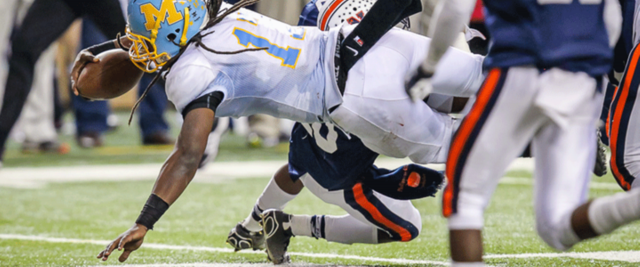Via The American Orthopaedic Society for Sports Medicine
COLORADO SPRINGS, CO – As artificial turf systems are increasingly used at all levels, new research is needed to understand how these surfaces can impact athlete safety. A study presented today at the American Orthopaedic Society for Sports Medicine’s (AOSSM) Annual Meeting in Colorado Springs, CO, shows how the infill weight of artificial turf surfaces can directly affect the number of injuries to high school football players.
The study, which is the first to directly compare football injuries as they relate to infill weight, and led by Michael Clinton Meyers, PhD, from Idaho State University in Pocatello, ID, was awarded the AOSSM’s first-annual STOP Sports Injuries award. This award recognizes top research leading toward significant awareness and change in the prevention of traumatic and overuse injuries in youth sports.
“Our research showed that as the artificial infill surface weight decreased, the incidence of game-related high school football trauma significantly increased,” noted Meyers. “This trend was consistent across numerous changes in playing conditions as well.”
The study included a total of 52 high schools participating across four states, with injuries evaluated over five competitive seasons (2010-14). Infill systems consisted of sand and/or rubber, and were divided into four categories based on pounds per square foot. The injury totals were significantly lower when infill rates were at a level greater than 9 pounds per square foot.
“Based on our findings, we would recommend that high school football fields contain a minimum of 6.0 pounds per square foot of infill weight to optimize player safety on artificial surfaces,” Meyers commented. “With the amount of athletes playing football, and the setbacks associated with injuries, we hope this research will help decrease these numbers and make football safer for young athletes.”
The researchers noted findings warrant further investigation, and cannot be generalized to other levels of competition beyond those included in the study.
The American Orthopaedic Society for Sports Medicine (AOSSM) is a global leader in orthopaedic sports medicine education, research, communication and fellowship, and includes national and international sports medicine leaders. The Society works closely with many other sports medicine specialists, including athletic trainers, physical therapists, family physicians, and others to improve the identification, prevention, treatment, and rehabilitation of sports injuries. AOSSM is also a founding partner of the STOP Sports Injuries campaign to prevent overuse and traumatic injuries in kids.


